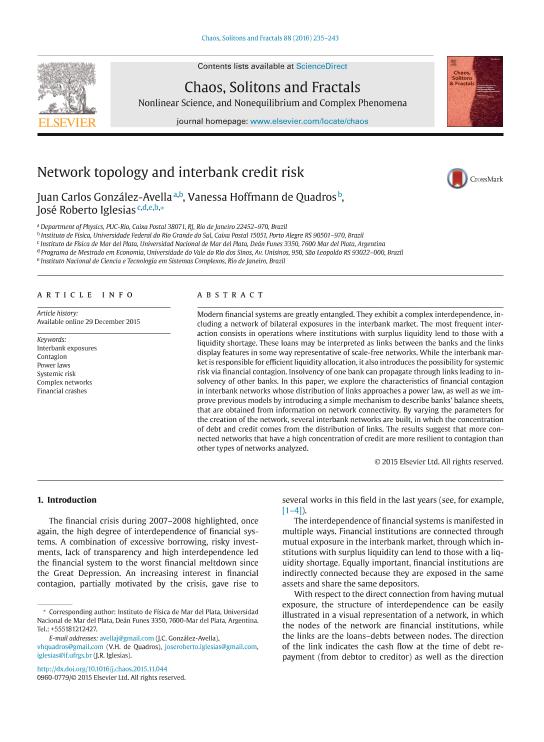Mostrar el registro sencillo del ítem
dc.contributor.author
González Avella, Juan Carlos
dc.contributor.author
Hoffmann de Quadros, Vanessa
dc.contributor.author
Iglesias, José Roberto

dc.date.available
2024-03-15T12:55:38Z
dc.date.issued
2016-07
dc.identifier.citation
González Avella, Juan Carlos; Hoffmann de Quadros, Vanessa; Iglesias, José Roberto; Network topology and interbank credit risk; Pergamon-Elsevier Science Ltd; Chaos, Solitons And Fractals; 88; 7-2016; 235-243
dc.identifier.issn
0960-0779
dc.identifier.uri
http://hdl.handle.net/11336/230664
dc.description.abstract
Modern financial systems are greatly entangled. They exhibit a complex interdependence, including a network of bilateral exposures in the interbank market. The most frequent interaction consists in operations where institutions with surplus liquidity lend to those with a liquidity shortage. These loans may be interpreted as links between the banks and the links display features in some way representative of scale-free networks. While the interbank market is responsible for efficient liquidity allocation, it also introduces the possibility for systemic risk via financial contagion. Insolvency of one bank can propagate through links leading to insolvency of other banks. In this paper, we explore the characteristics of financial contagion in interbank networks whose distribution of links approaches a power law, as well as we improve previous models by introducing a simple mechanism to describe banks´ balance sheets, that are obtained from information on network connectivity. By varying the parameters for the creation of the network, several interbank networks are built, in which the concentration of debt and credit comes from the distribution of links. The results suggest that more connected networks that have a high concentration of credit are more resilient to contagion than other types of networks analyzed.
dc.format
application/pdf
dc.language.iso
eng
dc.publisher
Pergamon-Elsevier Science Ltd

dc.rights
info:eu-repo/semantics/openAccess
dc.rights.uri
https://creativecommons.org/licenses/by-nc-sa/2.5/ar/
dc.subject
COMPLEX NETWORKS
dc.subject
CONTAGION
dc.subject
FINANCIAL CRASHES
dc.subject
INTERBANK EXPOSURES
dc.subject
POWER LAWS
dc.subject
SYSTEMIC RISK
dc.subject.classification
Otras Ciencias Físicas

dc.subject.classification
Ciencias Físicas

dc.subject.classification
CIENCIAS NATURALES Y EXACTAS

dc.title
Network topology and interbank credit risk
dc.type
info:eu-repo/semantics/article
dc.type
info:ar-repo/semantics/artículo
dc.type
info:eu-repo/semantics/publishedVersion
dc.date.updated
2024-03-15T11:38:09Z
dc.journal.volume
88
dc.journal.pagination
235-243
dc.journal.pais
Estados Unidos

dc.description.fil
Fil: González Avella, Juan Carlos. Universidade Federal do Rio Grande do Sul; Brasil. Pontifícia Universidade Católica do Rio de Janeiro; Brasil
dc.description.fil
Fil: Hoffmann de Quadros, Vanessa. Universidade Federal do Rio Grande do Sul; Brasil
dc.description.fil
Fil: Iglesias, José Roberto. Universidade Federal do Rio Grande do Sul; Brasil. Universidad de Vale do Rio dos Sinos; Brasil. Consejo Nacional de Investigaciones Científicas y Técnicas. Centro Científico Tecnológico Conicet - Mar del Plata. Instituto de Investigaciones Físicas de Mar del Plata. Universidad Nacional de Mar del Plata. Facultad de Ciencias Exactas y Naturales. Instituto de Investigaciones Físicas de Mar del Plata; Argentina
dc.journal.title
Chaos, Solitons And Fractals

dc.relation.alternativeid
info:eu-repo/semantics/altIdentifier/doi/http://dx.doi.org/10.1016/j.chaos.2015.11.044
Archivos asociados
